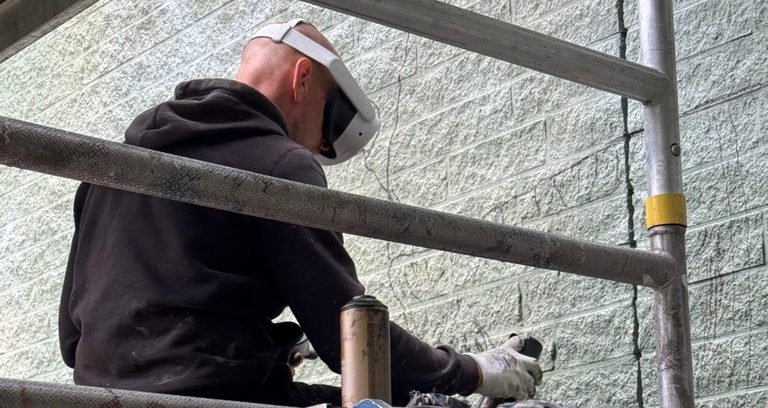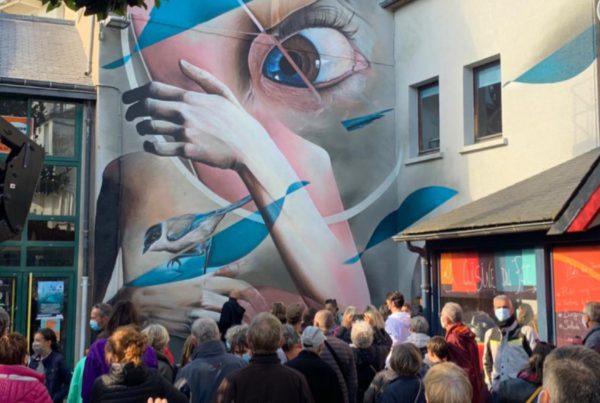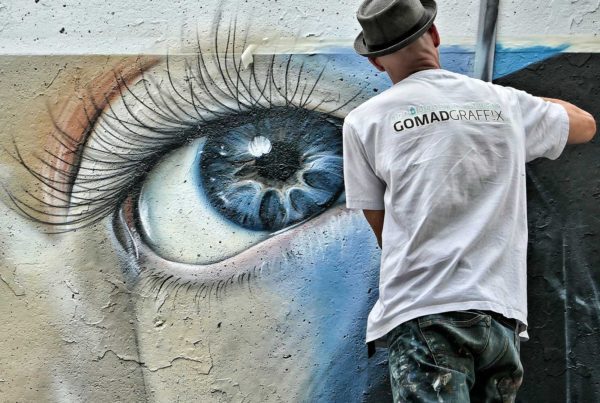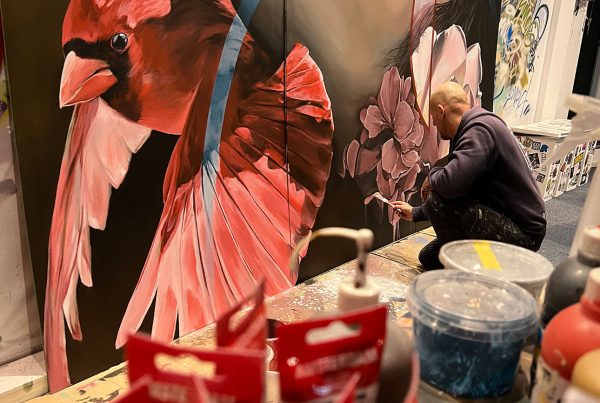How to Use Virtual Reality to Sketch and Trace large scale Murals Faster and Smarter with the Meta Quest 3S VR headset and the Contour app

Recently, I tried something new: using a “Meta Quest 3S VR headset to sketch with Contour app and trace my mural directly on the wall”.
It turned out to be a true game-changer.
For as long as I’ve been painting graffiti and murals (since 1985), one of the most time-consuming steps has been getting my design up on the wall because this has to be as perfect as possible. So I tried something new: Trace with VR and Contour app. At first I was sceptic about this but my collegae Mister Copy said ‘Just do it!’.
Traditionally, I’ve sketched freehand but when the walls got bigger and higher and my style changed from letters to figurative art I started using square grids.
The last decade I used the doodle grid to transfer my sketches on the wall. But sometimes the doodle grid stays visible through all the layers of paint and this affects the end result of the mural in a bad way. Some mural artists even put small pieces of tape in different colors on the wall which they use as a grid reference. But if you have a scaffolding in front of your wall, a doodle grid or tape grid are impossible to use because you can’t make a picture from a distance.
I got introduced to the Doodle Grid technique back in 2016 by my colleagues TelmoMiel during the silo art project of Kings of Colors festival in the city of Den Bosch, the Netherlands.
Marcus ‘GOMAD’ Debie
Still the quickest and precise way to sketch and trace a mural was using a projector. Some artists claim that using a projector is cheating but I believe if you can safe time and be accurate at the same time why not use a projector. As specifically if you’re an experienced artist able to use all techniques mentioned before. In my opinion it’s always better to spend more time at the painting process and details rather than in the sketch. Some challenges with a projector can be trees or other objects in the way, your own shadow or during bigger projects the shadow of your boomlift blocking the projection of your sketch. And you have to wait till it’s dark to have the best projection.
Of course all these techniques work, but they can also feel like a tedious warm-up before the real creative process begins.
In this article:
- From Grids to Sketch with Contour app
- What are the Key Advantages of VR Mural Projection?
- The Challenges of VR Sketching
- Alternative 'Sketchar' app
- Why Virtual Reality to Sketch with Contour app and Trace large scale Murals with the Meta Quest 3S VR headset Is a Game-Changer for Mural Artists
- In practice
- Quick set-up steps
- Final Thoughts
From Grids to Sketch with Contour app
- Freehand sketch → old school, but not precise
- Square grids → precise but time-consuming
- Doodle grids → more playful, but still slow
- Taped grids → simple, but also time-consuming
- Projection → simple, fast and precise, but not always possible
- VR projection → the design appears instantly on the wall, ready to trace
I still create my designs digital in Photoshop, but instead of mapping it out square by square or doodle by doodle, I am able to project the sketch with Contour app at full scale through my headset. Standing in front of a huge blank wall, I already “see” the mural as if it’s already finished and can start “tracing the sketch” immediately.
What are the Key Advantages of VR Mural Projection?
Here’s what I noticed after using VR and the Contour app to sketch a murals:
- Time-saving – No more spending hours on grids
- Daylight visibility – Can also be used in bright sunlight
- High precision – The mural matches my digital design (almost) perfectly
- Creative freedom – I can move elements around on the spot to fit the wall
- Immersive experience – It feels like stepping into the artwork before painting
The Challenges of VR Sketching
Of course, VR Sketch with Contour app isn’t flawless (yet). Some of the issues I ran into:
- Battery life – Longer sessions need extra planning and an extra battery-pack is a pre
- Setup alignment – The projection can shift slightly if not calibrated well. And adjusting during sketching is hard
The first time I tried it, parts of my sketch drifted a bit, and I ended up laughing while retracing lines. As long this is not happening with an important part like a face, you’ll be fine. Don’t get scared by these drifts, just go with the flow and keep practicing. That’s part of the learning curve, and still faster than gridding everything.

GOMAD in action using the VR headset and controllers to sketch with Contour app for the first time.
Tip: Save your artwork as a square file in hi-resolution and transparant PNG format to reduce the shifting and distortion, and start with the most important part of the design.
Alternative ‘Sketchar’ app
Sketchar, though I have not tried it yet, is likely another AR/VR tool that also assists with transferring designs, potentially offering a wider range of features or a different approach, as suggested by it being mentioned in comparison to Contour. The key difference lies in their focus: Contour is focused on tracing outlines using passthrough, while the term Sketchar suggests a broader set of capabilities for creative work, potentially including sketching and more detailed adjustments in augmented or virtual reality.
Why Virtual Reality to Sketch with Contour app and Trace large scale Murals with the Meta Quest 3S VR headset Is a Game-Changer for Mural Artists
Using a VR headset doesn’t replace traditional methods entirely. Sometimes the common techniques may still the better choice depending on the situation. But VR adds a powerful new option to the muralist’s toolkit, that’s for sure.
What does VR sketching mean for mural artists?
- Faster project kick-off
- Less technical prep, more focus on painting
- A better match between digital design and final mural
- New ways to interact with walls of any size
I tried this on landscape walls of 15 meters long and portrait walls of 15 meters high. It works the same way, but keep in mind the shifting when you go up with a lift.
I am still looking for a solution the have no image-shifting but maybe Contour can come up with an update fixing this problem.

In practice
First convert your design into a hi-resolution PNG file (preferably square size and transparent), and don’t forget to put a center point* on the design as reference. You’ll need this later. Upload the file to a cloud service like Google Drive, then accessing it from the headset’s browser and downloading it to your headset into your Download folder.
Your file can be a line sketch or just the original design in full color, whatever you prefer. Now you can access and open the file through the Contour app.
Quick set-up steps
1. Open the Contour app:
Launch the Contour app on your Meta Quest headset.
2. Access artwork:
Inside the app, select the option for “Artwork” or similar to view your images.
3. Choose your design:
Your uploaded design should appear in the Download folder. Select it to load it into the app.
4. Position and scale:
Once loaded, you can position the design by pinpointing it on the center* of the wall, measure this exactly and match this with the center point on the design. Then scale, and adjust the depth and angle of your design on the real-world surface you are viewing through the headset’s passthrough.
You can position, scale, do tilt and shift rotation in 3D. But you can also pull and push the design out or into the wall till you have adjusted it the way you want it. Then ‘fix’ this image to start tracing.
Final Thoughts
My first experiences with trace with VR and Contour app have been exciting, challenging, and inspiring. Instead of losing energy on grids, I can focus more on the painting process, the part I love most. Although the first times were a but harder figuring out this new technique and the do’s and don’ts, it took me almost as much time as doing a doodle grid. Especially when you run out of power, but after a few practice rounds you’ll get the hang of it and then the fun starts. I definitely will keep on using this new sketching tool, so for me it’s a keeper.
And this is only the beginning. Technology like VR will continue to reshape the way we create murals and street art. See the mural I made, sketching with the Contour app using a VR headset Meta Quest 3S.
Curious to see how it looks in practice? I’m planning to share a behind-the-scenes video on this topic soon at my YouTube channel. Let me know if you’d like to see it!




